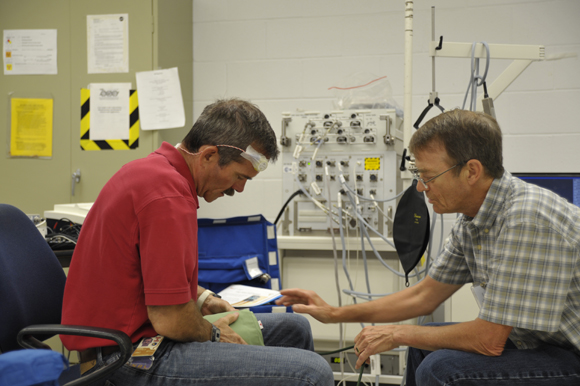BP Reg: Predicting fainting in astronauts
The Canadian science experiment Blood Pressure Regulation and Risk of Fainting on Return from Space (BP Reg) studied why some astronauts are more likely to faint or experience dizziness after their missions by observing how their bodies react to changes in blood pressure.
Chris Hadfield and Heart Health in Space
Canadian astronaut Chris Hadfield is the test subject for BP Reg, which is lead by Dr. Richard Hughson of the University of Waterloo. Results of this experiment could help us to better understand the human cardiovascular system and mechanisms that lead to fainting, which in turn could help reduce injury, especially for the elderly. (Credit: CSA/NASA)
Background
During space flight, the human body adjusts to the unusual microgravity environment. But after spending many months aboard the International Space Station, it can be difficult to re-adapt to life on Earth. When an astronaut returns to Earth, the sudden pull of gravity causes blood to quickly collect in the lower body, so less oxygen-rich blood gets to the brain.
Up to 80% of astronauts returning from long-duration missions suffer from bouts of light headedness, with some even experiencing fainting spells. These low-blood-pressure incidents present a danger to astronauts when they're back on Earth.
Objectives
BP Reg aimed to:
- determine which astronauts were more likely to faint or feel dizzy and should therefore take preventive measures
- verify if a fingertip blood pressure monitor could be used as a reliable measure of cardiac output, the volume of blood pumped by the heart each minute
Impacts on Earth
The knowledge gained from BP Reg may have health applications for older adults. This study's findings could help in preventing falls caused by sudden changes in blood pressure. Fainting incidents often lead to bone fractures in the elderly, according to BP Reg's researcher, Dr. Richard Hughson. This unique Canadian project could contribute to the development of methods to screen for individuals in the general population who are prone to fainting and falling.
How it worked
Eight astronauts participated in this study.
Scientists designed an in-flight test to simulate the challenges experienced by the body upon return to Earth. The test produces a sudden drop in blood pressure by placing inflating cuffs around the astronauts' upper legs to temporarily restrict blood flow. Air is then quickly released from the cuffs, to mimic a rapid transition from sitting to standing.
- Before the mission, researchers measured astronauts' normal standing blood pressure.
- Once aboard the Space Station, astronauts performed the cuff procedure on themselves to collect data in microgravity.
- Back on Earth, scientists again measured astronauts' standing blood pressure.
During each session, astronauts wore fingertip blood pressure monitors while performing an independent method to calculate cardiac output.
Results
The leg cuff test helped scientists study a blood pressure response that was equivalent to “standing up” in space. The rate of the blood pressure drop indicated how efficiently the cardiovascular system controls blood pressure.
Researchers found that the leg cuff test helped determine which astronauts should take preventive measures to avoid collapsing on return to Earth. These measures would be:
- increased medical monitoring
- greater liquid consumption
- changes to exercise
- wearing compression garments on the legs
- use of a lower body suction device to mimic gravity
BP Reg’s second objective was to compare two methods of measuring cardiac output. While previous studies had observed higher cardiac output in space, BP Reg confirmed those findings but determined that the more convenient fingertip blood pressure monitor was not as accurate as the breathing test in detecting the change.
The lung function test also showed that astronauts in space have higher levels of carbon dioxide dissolved in their blood, which could be linked to the vision changes undergone by some astronauts during space flight.
One of the measures to prevent astronauts from being uncomfortable when re-adapting to Earth is the use of “vacuum pants,” or lower body negative pressure devices. They are designed to help astronauts prepare for return to Earth by simulating how gravity normally affects blood and fluid throughout the body.
Timeline
The experiment was performed from 2012 to 2015. Canadian astronaut Chris Hadfield was its first participant.

Canadian Space Agency (CSA) Astronaut Chris Hadfield (left) undergoing pre-flight training on the BP Reg experiment with lead researcher, Dr. Richard Hughson (right). (Credit: CSA)
Research team
Principal investigator
- Dr. Richard Hughson of the Schlegel-University of Waterloo Research Institute for Aging
Co-investigators
- Danielle Greaves, M.Sc., University of Waterloo, Ontario
Explore further
- ISS experiment shows the risks of a sedentary lifestyle
- Studying heart health in space
- Rubber vacuum pants that suck
- Date modified:
